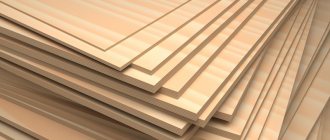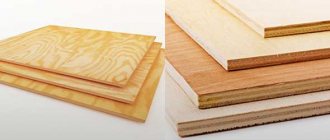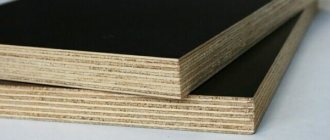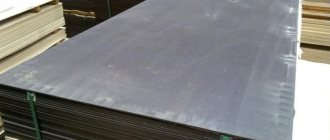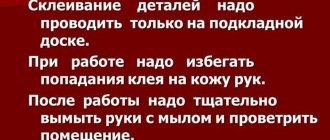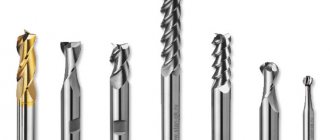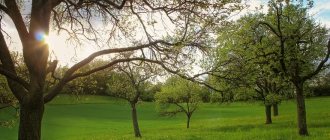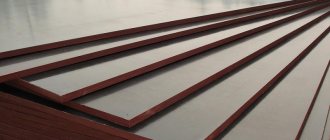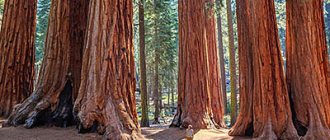The finishing of some surfaces indoors or outdoors requires the use of a material with improved properties. For such situations, moisture-resistant plywood is suitable, capable of withstanding various harmful effects. The products are divided into several main varieties, which exhibit high stability in a humid environment. A correct assessment of existing parameters allows you to achieve a high-quality result.
What does FSF mean?
FSF – stands for waterproof plywood. The full name of this variety is phenol-formaldehyde resin plywood. It is possible to produce an assortment of waterproof plywood, presented in the table:
| By format | 1220x2440 mm, 1250x2500 mm, 1250x2440 mm |
| By thickness | 6.5; 9.5; 12; 15; 18; 21 ;24 ;27 ;30 mm |
| By grade | II/II (BB/BB), II/III (BB/SR), III/III (SR/SR), III/IV(SR/S), IV/IV (S/S) |
| By surface treatment | NSh-not polished, Sh2-polished on both sides |
Price
The cost of moisture-resistant plywood is determined by its size and the components included in the gluing composition:
- Birch FC - 280-1380 rubles.
- Birch FSF - 630-2300 rubles.
- Coniferous FSF - 530-1380 rubles.
- Laminated - 1180 -1480 rubles.
Moisture-resistant plywood is a very popular product today. It can be used in various fields of industry.
In the article you can read about OSBI plywood.
Most often, it shows its best side in the interior and exterior decoration of the house. When choosing products, you must be guided by such criteria as the level of moisture resistance, grade, type of wood and type of adhesive. It is these indicators that determine the quality of the product, which can be purchased at an affordable price.
Main advantages of the material
- The material is highly resistant to damage due to its multilayer structure with layers of multidirectional wood fibers. The wear resistance of plywood to bending and tearing is explained by the decent resistance of the material structure;
- It also demonstrates high strength and reliable quality thanks to the use of adhesive compositions that are exclusively safe for human health. The material is not exposed to liquid moisture or water vapor: it does not unstick or swell;
- FSF plywood is easy to process and install, and working with it does not require special skills. The material lends itself perfectly to sawing and drilling. And to fix it with your own hands on the surface, standard screws or nails are enough;
- This material combines perfectly with other construction and finishing materials. Plywood is often used as an auxiliary material in the process of finishing some structures during the construction of roofs, wall partitions, as well as in the manufacture of furniture;
- In addition to these qualities, it can be emphasized that the price of FSF plywood is very affordable.
Handmade production of moisture-resistant plywood
Now let's look at how to make plywood moisture resistant with your own hands. Of course, for large volumes, all the methods listed below are not suitable, since their use will be irrational, but if you need to make a couple of sheets less susceptible to excessive humidity at home, they are quite suitable.
So, how to make moisture-resistant plywood:
- Applying a paint layer.
The process is carried out in several steps:
- Sanding the surface of a wood-laminated board;
- Putty, which allows you to eliminate possible flaws;
- Priming to increase the adhesive properties of the material;
- Painting;
Tip: if you are preparing plywood for interior work, it is recommended to use acrylic-based paints or varnishes, as they do not emit any toxins.
- Drying oil. The answer to the question of how to impregnate plywood for moisture resistance is very simple: any drying oil purchased in a specialized store. This substance will penetrate the wood pores and prevent water from penetrating there. It must be applied until the tree simply stops absorbing it;
Treatment of wood-laminated board with drying oil
- Fiberglass. In the role of fiberglass at home, gauze is quite suitable, which is applied to the surface of the plywood and then varnished.
Coniferous and deciduous
Domestic manufacturers are engaged in the production of FSF sheets from various tree species.
Note! The latter type has a higher cost, which is due to a higher level of strength than that of plywood sheets made from coniferous trees.
It is important to say that such a difference will be real in cases where each layer of material is made of birch veneer. If the inner layers of plywood are made from coniferous veneer, then the sheet will still remain birch, but its strength level will be reduced. But practice shows that this rarely happens.
Difference in number of layers
Its strength depends on the number of layers of plywood. She may be:
- three-layer;
- four-layer;
- five-layer;
- plywood with many layers.
In any case, the layers are applied perpendicularly.
Phenol-formaldehyde resins
By the method of polycondensation of substances called phenol and formaldehyde under different conditions, a fairly wide group of synthetic resins is obtained - phenol-formaldehyde resins.
The complex of properties of the final substance is influenced by:
- temperature regime;
- environment for the polycondensation reaction.
Packaged phenol-formaldehyde resin
Properties
The properties of phenol-formaldehyde resins include:
- color: can vary from dark red to dark brown;
- low solubility in water;
- emission of phenol and formaldehyde, as well as their compounds.
Grade
FSF plywood is divided into several grades.
Depending on a particular variety, its price and properties may vary:
- low-grade material has knots and traces of veneer joints;
- and 1st grade plywood does not have any defects in appearance.
Note! Also, the price level for this material can be influenced by the place of its production and, of course, the image of the manufacturing company.
First-class building material
Today, a potential buyer has the opportunity to choose a brand and grade of plywood from a wide range presented by both domestic manufacturers and foreign companies.
General information
Plywood has been known to mankind for a very long time. The first machines for its production appeared in the 18th century.
True, at that time natural casein glue was used for gluing veneer. This binding component is environmentally friendly, however, completely unstable to moisture.
Therefore, the first plywood could only be used in dry conditions. Over time, the technology for manufacturing the material, of course, improved, including the use of new types of adhesives for gluing veneer. As a result, nowadays almost any plywood is moisture resistant, since it can withstand moisture to one degree or another.
This is due to the fact that synthetic resins that are poorly soluble in water are used for gluing veneer. The only thing is that some brands tolerate moisture well and can even be used under water, while others eventually begin to delaminate and rot. The exception is the FBA brand, made on the basis of water-soluble albumin-casein glue.
Plywood production
Features of application
Due to the use of phenol-formaldehyde resin in the process of creating this building material, it is provided with increased moisture resistance and phenol emission. However, this fact significantly limits and at the same time expands the possibilities of its application. After all, such plywood can be used for external work due to its high degree of moisture resistance, but it is unlikely to be suitable for internal work due to the toxicity of the resin used.
Boat made of moisture-resistant plywood
That's why I use this material:
- during construction work;
- in the process of production of packaging materials;
- in furniture production;
- in the automotive industry;
- in carriage building.
Construction works
In construction, the material is used in the following processes:
- when creating formwork from plywood with your own hands;
- during the construction of playgrounds and sports grounds;
- during the construction of temporary structures;
- when erecting fences for construction sites;
- when laying flooring during roof construction.
Roof made of moisture-resistant plywood
Furniture making
The material is used in the manufacturing of furniture products due to the fact that it is easy to cut and is distinguished by its resistance to damage. However, it is used exclusively for creating pieces of garden furniture, because... The formaldehyde resin contained in it can harm the health of humans and animals.
Specifications
This type of lumber is distinguished by its flexibility and endurance under daily loads. Plywood sheets are used for interior work and interior decoration. The layered base adds the necessary ductility and strength.
Various solid parts can be cut from large sheet sizes. The material does not burst or crack. Plywood is considered an environmentally friendly type of construction lumber. It has a uniform and uniform color coating.
Which plywood is better to choose? Before purchasing, you must carefully inspect the surface of the wooden sheets. There should be no large cracks or traces of adhesive components.
If the material is intended for decorating an interior space, then it is best to choose models of grades 1 and 3. They are considered more durable and hardy.
In addition, it is recommended to pay attention to the thickness of plywood products. The thinner the sheet, the greater the likelihood of external defects appearing on its plane. Such products are used for ceilings as final finishing. After this, it is treated with a protective varnish. The photo of plywood shows the laminated type of coating.
Protecting wood from external influences is the key to the reliability of a country houseWood is a natural raw material and a wonderful material
All about wooden lining - quality assessment, advantages of use and characteristics of the finishing material
Varieties
Applications of different types of plywood.
Based on the appearance of the top layer, moisture-resistant plywood is divided into 4 grades:
- It has small knots (no more than 3 pieces), large knots with a diameter of up to 1.5 cm and falling out elements up to 0.6 cm, small cracks no longer than 20 cm are allowed (2 pieces per 1 m). It is also possible to change the color of the surface of the material, but not more than 5%. No other defects should be observed.
- Pin and fused knots with a diameter of up to 2.5 cm, falling out elements with a diameter of up to 0.6 cm are allowed. There may be cracks no longer than 20 cm (2 pieces per 1 m). Discoloration and small fragments of wood are allowed.
- Loose knots with a diameter of 0.6 cm, cracks up to 2 mm wide and up to 30 cm long, discoloration, ripples and waviness may be observed.
- There may be falling elements up to 4 cm in diameter in unlimited quantities, multiple cracks, wood fragments, waviness and ripples.
A wide variety of moisture-resistant plywood allows you to easily choose the most optimal option for carrying out certain work.
